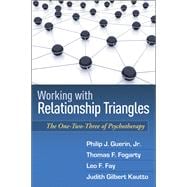
Note: Supplemental materials are not guaranteed with Rental or Used book purchases.
Purchase Benefits
What is included with this book?
| Relationship Triangles: Evolution of the Concept | p. 1 |
| A Historical Perspective | p. 3 |
| The Relevance of Triangles in Clinical Context | p. 20 |
| Three Types of Triangles | p. 22 |
| The Clinical Centrality of Triangles | p. 29 |
| Addressing Triangles in Therapy | p. 37 |
| Self-Focus | p. 42 |
| What a Triangle is Not | p. 46 |
| The Structure of Relationship Triangles | p. 51 |
| How to See a Triangle | p. 51 |
| Dissecting a Triangle's Structure | p. 58 |
| Emotional Process within Triangular Structure | p. 75 |
| Seeing Relationship Process | p. 75 |
| Process Questions | p. 81 |
| Emotional Process and Triangles | p. 85 |
| The Interaction of Structure, Process, and Function | p. 93 |
| The Relationship of Structure and Process | p. 93 |
| Mechanisms of Triangle Activation | p. 95 |
| Figuring Out Function | p. 98 |
| Introducing Triangles in Individual Therapy | p. 106 |
| Using Triangles in Individual Therapy | p. 109 |
| Placing Individuals' Symptoms in Context | p. 116 |
| Indications for Work with Triangles in Individual Therapy | p. 123 |
| Coaching and Direct Intervention with Triangles in Individual Therapy | p. 129 |
| Cases that Present with Relationship Problems | p. 130 |
| Cases with Developmental Problems | p. 132 |
| Cases of Refractory Anxiety or Depression | p. 140 |
| The Therapy Triangle | p. 145 |
| Extra familial Triangles in Marital Conflict | p. 149 |
| The Extramarital Affair Triangle | p. 151 |
| Social Network Triangles | p. 161 |
| Occupational Triangles | p. 166 |
| Marital Triangles within the Family | p. 169 |
| Primacy of Attachment and Hierarchy of Influence | p. 169 |
| Displacement of Conflict | p. 171 |
| In-Law Triangles | p. 172 |
| The Primary Parental Triangle of Each Spouse | p. 184 |
| Triangles with the Children | p. 187 |
| Child and Adolescent Triangles | p. 190 |
| School-Related Triangles | p. 190 |
| Social Network Triangles | p. 194 |
| Symptomatic Child Triangles | p. 198 |
| Symptomatic Child and Adolescent Triangles within the Family | p. 204 |
| The Target Child | p. 204 |
| The Parent and Sibling Triangle | p. 207 |
| The Sibling Subsystem Triangle | p. 209 |
| The Three-Generational Triangle | p. 213 |
| Stepfamily Triangles | p. 216 |
| Conclusion: Becoming a "Triangle Doctor" | p. 222 |
| The Pervasiveness of Triangles in Relationships and in Therapy | p. 222 |
| Methods of Management of Relationship Triangles | p. 223 |
| Summary and Conclusion | p. 234 |
| References | p. 237 |
| Index | p. 239 |
| Table of Contents provided by Ingram. All Rights Reserved. |
The New copy of this book will include any supplemental materials advertised. Please check the title of the book to determine if it should include any access cards, study guides, lab manuals, CDs, etc.
The Used, Rental and eBook copies of this book are not guaranteed to include any supplemental materials. Typically, only the book itself is included. This is true even if the title states it includes any access cards, study guides, lab manuals, CDs, etc.